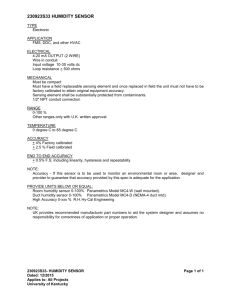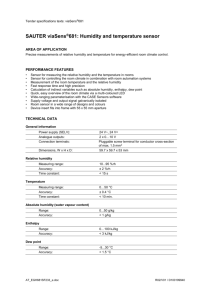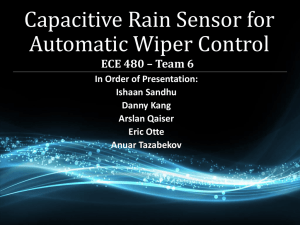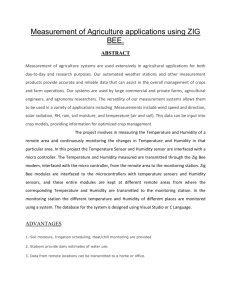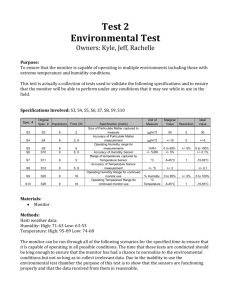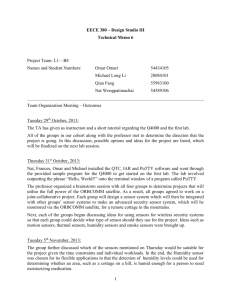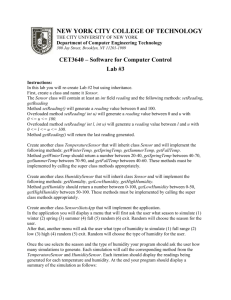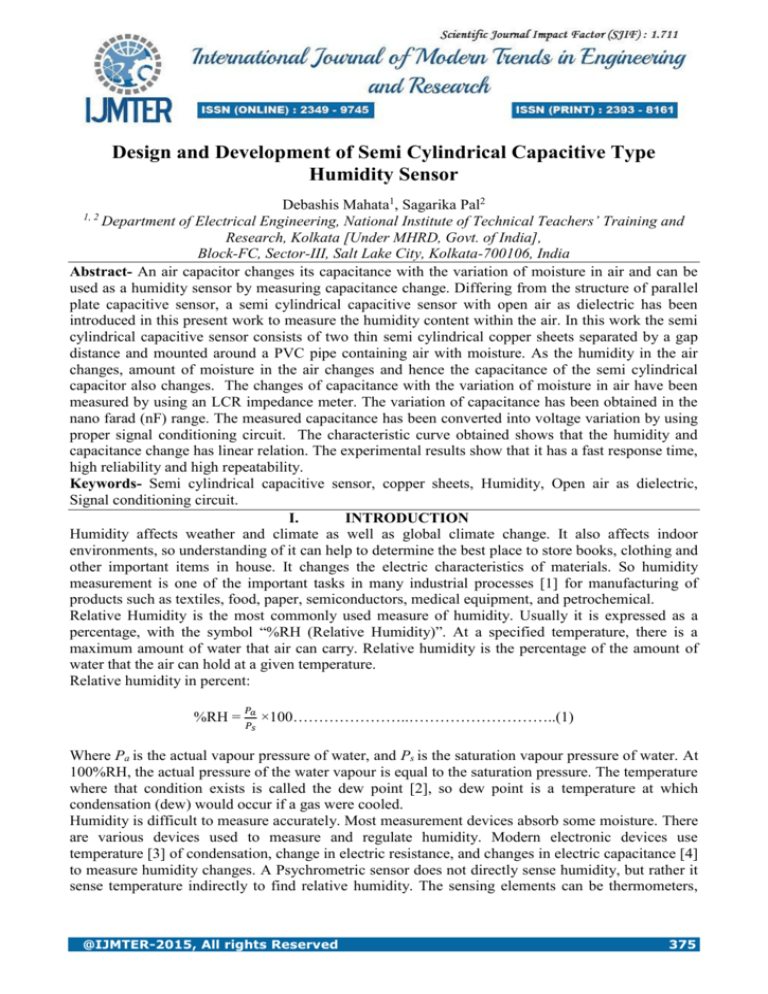
Design and Development of Semi Cylindrical Capacitive Type
Humidity Sensor
Debashis Mahata1, Sagarika Pal2
Department of Electrical Engineering, National Institute of Technical Teachers’ Training and
Research, Kolkata [Under MHRD, Govt. of India],
Block-FC, Sector-III, Salt Lake City, Kolkata-700106, India
Abstract- An air capacitor changes its capacitance with the variation of moisture in air and can be
used as a humidity sensor by measuring capacitance change. Differing from the structure of parallel
plate capacitive sensor, a semi cylindrical capacitive sensor with open air as dielectric has been
introduced in this present work to measure the humidity content within the air. In this work the semi
cylindrical capacitive sensor consists of two thin semi cylindrical copper sheets separated by a gap
distance and mounted around a PVC pipe containing air with moisture. As the humidity in the air
changes, amount of moisture in the air changes and hence the capacitance of the semi cylindrical
capacitor also changes. The changes of capacitance with the variation of moisture in air have been
measured by using an LCR impedance meter. The variation of capacitance has been obtained in the
nano farad (nF) range. The measured capacitance has been converted into voltage variation by using
proper signal conditioning circuit. The characteristic curve obtained shows that the humidity and
capacitance change has linear relation. The experimental results show that it has a fast response time,
high reliability and high repeatability.
Keywords- Semi cylindrical capacitive sensor, copper sheets, Humidity, Open air as dielectric,
Signal conditioning circuit.
I.
INTRODUCTION
Humidity affects weather and climate as well as global climate change. It also affects indoor
environments, so understanding of it can help to determine the best place to store books, clothing and
other important items in house. It changes the electric characteristics of materials. So humidity
measurement is one of the important tasks in many industrial processes [1] for manufacturing of
products such as textiles, food, paper, semiconductors, medical equipment, and petrochemical.
Relative Humidity is the most commonly used measure of humidity. Usually it is expressed as a
percentage, with the symbol “%RH (Relative Humidity)”. At a specified temperature, there is a
maximum amount of water that air can carry. Relative humidity is the percentage of the amount of
water that the air can hold at a given temperature.
Relative humidity in percent:
1, 2
%RH =
𝑃𝑎
𝑃𝑠
×100…………………..………………………..(1)
Where Pa is the actual vapour pressure of water, and Ps is the saturation vapour pressure of water. At
100%RH, the actual pressure of the water vapour is equal to the saturation pressure. The temperature
where that condition exists is called the dew point [2], so dew point is a temperature at which
condensation (dew) would occur if a gas were cooled.
Humidity is difficult to measure accurately. Most measurement devices absorb some moisture. There
are various devices used to measure and regulate humidity. Modern electronic devices use
temperature [3] of condensation, change in electric resistance, and changes in electric capacitance [4]
to measure humidity changes. A Psychrometric sensor does not directly sense humidity, but rather it
sense temperature indirectly to find relative humidity. The sensing elements can be thermometers,
@IJMTER-2015, All rights Reserved
375
International Journal of Modern Trends in Engineering and Research (IJMTER)
Volume 02, Issue 08, [August– 2015] ISSN (Online):2349–9745 ; ISSN (Print):2393-8161
RTD’s, or some other type of temperature sensor. The first sensing element, the dry bulb measures
ambient temperature. The second sensing element, the wet bulb has been enclosed in a wick
saturated with distilled water. Air forced across the wet bulb creates evaporation, which cools it
below ambient temperature. At temperatures above the freezing point of water, evaporation of water
from the wick lowers the temperature, so that the wet bulb thermometer usually shows a lower
temperature than that of the dry bulb thermometer. There after many techniques are developed to
measure or sense humidity and relative humidity. Smart humidity [5] sensor and monitoring of
intelligent humidity [6] measurement systems have been discussed. In recent years many types of
capacitive humidity sensors [7], [8] have been developed. Most recent type is air capacitor [9] with
open air as dielectric where two parallel plates have been used for capacitor plates. On that air
capacitor theoretical and experimental values have been compared and the dielectric constant of air
at different moisture in air has been calculated. Since a capacitive sensor has very weak output signal
so a proper signal conditioning is required to convert the signal into voltage signal. Various Signal
conditioning circuits have been proposed to convert capacitance to voltage [10].
Differing from the structure of parallel plate capacitive sensor, a semi cylindrical capacitive [11],
[12], [13] humidity sensor with open air as dielectric has been developed in the present work.
According to the variation of moisture in air at room the capacitance will be changed. And from that
change of value of capacitance the humidity will be measured or sensed. As the sensor has semi
cylindrical structure so it is possible to pass all moisture air throughout the plate region to get better
sensor capacitance variation during the change of moisture in air. Also it has been tried to show how
semi cylindrical capacitive sensor capacitance is varied in accordance with the humidity. The sensor
capacitance is converted into corresponding voltage signal using proper signal conditioning circuit.
II.
Capacitive Sensing Technique for Semi Cylindrical Capacitive Sensor
Semi-cylindrical capacitive sensor consists of two metal semi-cylindrical plates separated by a
minimum gap distance. The two metal semi cylinders have the radius R and a minimum gap distance
d. In the present paper no di-electric has been used. Fig. 1(a) shows the architecture of the semi
cylindrical capacitive sensor where two metal sheets is bended to form a semi cylinder and Fig. 1(b)
shows the top view of the semi-cylindrical capacitive sensor.
(a)
(b)
Fig. 1. (a) Architecture of semi-cylindrical capacitive sensor. (b) Top view of semi-cylindrical capacitive sensor.
Minimum gap distance of two plates is d and after that it is incremented by a Δd distance. The
numerical analysis method is applied to approximate the capacitance of the semi-cylindrical
capacitive sensor. Fig. 2(a) shows the structure of the semi cylindrical capacitive sensor for
numerical analysis method. The capacitance between two semi cylindrical metallic plates can be
modified as each pairs of two unit metal plates with an increment Δd distance shown in Fig. 2(b).
@IJMTER-2015, All rights Reserved
376
International Journal of Modern Trends in Engineering and Research (IJMTER)
Volume 02, Issue 08, [August– 2015] ISSN (Online):2349–9745 ; ISSN (Print):2393-8161
(a)
(b)
Fig. 2. (a) Approximate structure of the semi-cylindrical capacitive sensor without dielectric for numerical analysis
method. (b) Equivalent capacitors between A and B terminals of semi cylindrical plates.
So the capacitance of two metal semi cylinders without dielectric can be expressed as:
C0=2 0 1 A × [ 1
d
1
1
1
] + 01 A
.......
d d d 2d
d (n 1)d
2R
n
= 2 0 1 A × [
i 1
1
] + 01 A ……………………….………..(2)
d (i 1)d
2R
Where 0 is the permittivity of free space of magnitude 8.854 (pF/m), 1 is the dielectric constant of
air, n the cutting number for numerical analysis, A is the unit area of metal semi-cylinders, and R is
the radius of the semi cylinder. Equation 2 gives the general equation of capacitance of a semi
cylindrical capacitor. So if 1 , the dielectric constant of air within the cylinder varies, capacitance
between the semi cylindrical plates will also vary because of the variation of moisture content in air.
Thus humidity measurement in terms of the capacitance of the semi cylindrical plates can be
possible.
III.
Design of the Semi Cylindrical Capacitive Sensor
The semi cylindrical capacitive sensor has been designed and constructed from two Copper sheets
each of thickness 0.5 mm, length 300 mm and width 164 mm. Each plate has been bent to form a
semi cylindrical shape. These two semi cylindrical sheets have been mounted inside a PVC pipe
using adhesives so that there has no air gap between the capacitor plates and the inside wall of the
tank. Fig. 3 shows the Isometric view of constructed sensor with different parameters. Two semi
cylindrical plates are separated by a gap distance of 1.0 mm. The inner diameter of the PVC tank is
105 mm.
@IJMTER-2015, All rights Reserved
377
International Journal of Modern Trends in Engineering and Research (IJMTER)
Volume 02, Issue 08, [August– 2015] ISSN (Online):2349–9745 ; ISSN (Print):2393-8161
Fig. 3. Isometric view of semi cylindrical capacitive humidity sensor (All dimensions are in mm).
IV.
Signal Conditioning Circuit for Semi Cylindrical Capacitive Sensor
The variation of capacitance due to change in moisture content in air has been converted into voltage
variation with the help of a series RLC resonating circuit as shown in Fig. 4. At resonant condition
the output voltage has been taken out from the resistive end of RLC series circuit. The sensor
capacitor signal has been connected in parallel tothe fixed capacitor of RLC series resonating circuit.
With the change of the sensor capacitance the output voltage has been changed.
Fig. 4. Signal conditioning circuit for semi cylindrical capacitive sensor.
At resonance of RLC series circuit, the inductive reactance becomes equal to capacitive reactancei.e,
XL = XC, and overall impedance, Z = R. So at series resonance the impedance of the series RLC
circuit is minimum and voltage drop across resistance is maximum. The output signal voltage
obtained from resistive terminal of RLC series resonating circuit is very low so it has been amplified
by the amplifier circuit. Amplification has been done in two stages with minimum gain to reduce
noise voltage amplification.
V.
Experimental Result
After designing the semi cylindrical capacitive humidity sensor and corresponding signal
conditioning circuit, the experiment has been done several times. From the experiment humidity and
corresponding sensor capacitance has been taken. In this work humidity has been measured by taking
@IJMTER-2015, All rights Reserved
378
International Journal of Modern Trends in Engineering and Research (IJMTER)
Volume 02, Issue 08, [August– 2015] ISSN (Online):2349–9745 ; ISSN (Print):2393-8161
a standard humidity sensor. Finally MATLAB software is performed to calculate theoretically the
capacitance between the two semi cylindrical plates taking 1 atmospheric pressure dielectric
constant, 1 of air using equation 1 and the calculated value of capacitance is also in the nano farad
range i.e. same order as that of the experimental value.With the data of humidity in %RH and
corresponding capacitance in nano farad, the graph has been plotted and shown in Fig. 5.
Fig. 5. Humidity Vs Capacitance Graph
From the graph of humidity Vs capacitance it has been shown clear that the graph is almost linear
with some error. For error calculation a trend line has been drawn with linear equation on the graph
of humidity and respective capacitance. Generated trend line equation is:
y = 0.0005x + 0.0109………………………………………..…...(3)
.
Where x has been defined as the variable of humidity and y has been defined as the variable of sensor
capacitance. From that equation 3 true value and % of error has been calculated. And error graph has
been drawn and shown in Fig. 6. From that error graph it has been clear that error occurs minimum
in that sensor. And the error varies from -0.30% to +1.2% which is within tolerable limit.
Fig. 6. Humidity Vs % of Error Graph
@IJMTER-2015, All rights Reserved
379
International Journal of Modern Trends in Engineering and Research (IJMTER)
Volume 02, Issue 08, [August– 2015] ISSN (Online):2349–9745 ; ISSN (Print):2393-8161
Voltage output VR (r.m.s.) after the series RLC resonating circuit and final amplified output voltage
V0 (r.m.s) after voltage amplification has been plotted against capacitance variation, which is shown
in Fig. 7 and 8. Output voltage V0 (r.m.s) has been plotted against humidity variation and have been
shown in Fig.9.
Fig. 7. Sensor Capacitance Vs Voltage across R
Fig. 8. Sensor Capacitance Vs Voltage after Amplification
@IJMTER-2015, All rights Reserved
380
International Journal of Modern Trends in Engineering and Research (IJMTER)
Volume 02, Issue 08, [August– 2015] ISSN (Online):2349–9745 ; ISSN (Print):2393-8161
Fig. 9. Humidity Vs Voltage after Amplification
VI.
CONCLUSIONS
It is to be noted that environment affects all humidity sensors in which they are measured and
monitored. Psychrometer has long been a popular method for monitoring humidity due to its
simplicity. Now many types of humidity sensors have been developed for better accuracy.
In this work a semi cylindrical capacitive sensor has been developed with open air containing
moisture as dielectric.
This setup can measure small capacitance change with respect to moisture changes in air regardless
of the environment temperature. After the complete experimental and circuit setup the various
experimental data at different stages and conditions have been taken for its performance analysis and
discussion. From the graph it has been observed that the characteristic is almost linear with
maximum error 1.5%. As a whole, it is observed that this method provides good accuracy and
repeatability within the selected range with low error. Therefore semi cylindrical capacitive sensor
with open air as dielectric may be designed for commercial purpose.
The present setup has been done in laboratory on a fixed table. This can be made portable with
proper setup. So far this has been developed to monitor capacitance change with respect to moisture
changes in air and has been converted to the corresponding voltage signal. So this setup can be
modified to measure and display humidity automatically. From the measured value, a circuit can be
developed to link with automatic humidity control devices in various industrial areas.
Variation of capacitance in very low humidity (less than 10% RH) and in very high humidity (greater
than 90% RH) is to be further studied.
REFERENCES
[1]. Wei Zhang, Simon X. Yang, Humidity Measurement in Harsh Industrial Environments, in Proceedings of the
2010 International Conference on Networking, Sensing and Control (ICNSC), Chicago, United States, April 1012, 2010, pp. 649-652.
[2]. O.Postolache, P.Girao, M.Pereira, C.Banha, Helena Ramos, Dew Point and Relative Humidity Smart Measuring
System, in Proceedings of the 21st IEEE Instrumentation and Measurement Technology Conference, vol. 1, May
18-20, 2004, pp. 82-86.
[3]. M. Bhuyan, R. Bhuyan, An On-Line Method for Monitoring of Relative Humidity Using Thermal Sensors, in
Proceedings of the IEEE/IAS International Conference on Industrial Automation and Control, 1995 (I A &
C'95), Hyderabad, India, January 5-7,1995, pp. 7-11.
[4]. Larry K. Baxter, Capacitive Sensors: Design and Applications, Wiley IEEE Press, August 1996.
[5]. Souhil Kouda, Zohir Dibi, Fayçal Meddour, Modeling of a Smart Humidity Sensor, in proceedings of the ICM
2008International Conference on Microelectronics, Sharjah, United Arab Emirates, December 14-17, 2008,
pp.135-138.
@IJMTER-2015, All rights Reserved
381
International Journal of Modern Trends in Engineering and Research (IJMTER)
Volume 02, Issue 08, [August– 2015] ISSN (Online):2349–9745 ; ISSN (Print):2393-8161
[6]. Liu Xuanchao, Liu Xiaolong, The Research on Intelligent Humidity Measurement System, in Proceedings of the
2010IEEE Second International Conference on Information Technology and Computer Science(ITCS), Kiev, July
24-25, 2010, pp. 178-181.
[7]. Paul E.Thoma, Jeannine O.Colla, Rosemary Stewart, A Capacitance Humidity-Sensing Transducer, IEEE
Transactions on Components, Hybrids, and Manufacturing Technology, Vol. 2, No. 3, 1979, pp. 321-323.
[8]. Jose Pelegri-Sebastia, Eduardo Garcia-Breijo, Javier Ibanez, Tomas Sogorb, Nicolas Laguarda-Miro, Jose
Garrigues, Low-Cost Capacitive Humidity Sensor for Application Within Flexible RFID Labels Based on
Microcontroller Systems, IEEE Transactions on Instrumentation And measurement, Vol. 61, No. 2, 2012, pp. 545553.
[9]. Jin Moon Choi, Tae Wan Kim, Humidity Sensor Using an Air Capacitor, KIEEME Transactions on Electrical
and Electronic Materials, Vol. 14, No. 4, 2013, pp. 182-186.
[10]. Boby George V, Jagadeesh Kumar, Switched Capacitor Signal Conditioning for Differential Capacitive Sensors,
IEEE Transactions on Instrumentation and Measurement, Vol. 56, No. 3, 2007, pp. 913-917.
[11]. Cheng-Ta Chiang, A Semicylindrical Capacitive Sensor with Interface Circuit Used for Flow Rate Measurement,
IEEE Sensors Journal, Vol. 6, No. 6, 2006, pp. 1564-1570.
[12]. Cheng-Ta Chiang, Yu-Chung Huang, A Semi-Cylindrical Capacitive Sensor with Interface Circuit Using for
Fluidic Measuring, in Proceedings of Instrumentation and Measurement Technology Conference(IMTC 2006),
Sorrento, Italy, 24-27 April 2006, pp. 2318-2322.
[13]. Sagarika Pal, Rasmiprava Barik, Design, Development and Testing of a Semi Cylinderical Capacitive Sensor for
Liquid Level Measurement, Sensors & Transducers Journal, Vol. 116, No. 5, 2010, pp. 13-20.
@IJMTER-2015, All rights Reserved
382

